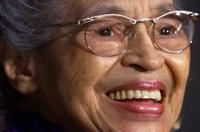Rosa Parks dies at 92
ROSA Parks, a black seamstress whose refusal to relinquish her seat to a white man on a bus in Montgomery, Alabama, almost 50 years ago grew into a mythic event that helped touch off the US civil rights movement of the 1950s and 1960s, has died. She was 92.
For her act of defiance, Parks — who died on Monday — was arrested, convicted of violating the segregation laws and fined $US10. In response, blacks in Montgomery boycotted the city's buses for nearly 13 months while mounting a successful Supreme Court challenge to the Jim Crow law that enforced their second-class status on the public bus system.
The events that began on that bus in December 1955 captivated the US and transformed a reluctant 26-year-old Montgomery Baptist preacher, Martin Luther King, into a key civil rights leader.
"Mrs Parks' arrest was the precipitating factor rather than the cause of the protest," King wrote in his 1958 book, Stride Toward Freedom. "The cause lay deep in the record of similar injustices."
Her simple act of civil disobedience was, in fact, a dangerous, even reckless move in 1950s Alabama. In refusing to move, she risked legal sanction and perhaps even physical harm, but she also clarified for public consumption far beyond Montgomery the cruelty and humiliation inherent in the laws and customs of segregation.
Rosa Louise McCauley was born in Tuskegee, Alabama, the older of two children of a farming family. Her father James also worked as a carpenter and mother Leona as a teacher.
She dropped out of high school to care for her ailing grandmother. It was not until she was 21 — and had been married to Raymond Parks for two years — that she earned a high school diploma.
Shy and soft-spoken, she often appeared uncomfortable with the near-beatification bestowed on her by blacks across the US.
Over the years myth tended to obscure the truth about Parks. As she later explained, she, like thousands of other blacks, was tired of being humiliated, of having to adapt to the byzantine rules, some codified as law and others passed on as tradition, that reinforced the inferior position of blacks.
Parks and her husband were active in the Montgomery chapter of the National Association for the Advancement of Coloured People.
Parks said she "gained strength to persevere in my work for freedom, not just for blacks but for all oppressed people", when she attended an interracial leadership conference in Tennessee in 1955. But as she rushed home from her job as a seamstress at a department store on December 1, 1955, the last thing on her mind was becoming "the mother of the civil rights movement", as many would later describe her.
On Montgomery buses, the first four rows were reserved
for whites. The rear was for blacks, who made up more than 75 per cent of the bus system's riders. Blacks could sit in the middle rows until those seats were needed by whites. Then they had to move to seats at
the rear, stand or, if there was no room, leave the bus.
Parks had already been ejected from a bus on the Cleveland Avenue route over a confrontation with driver James Blake in 1943. As fate would have it, he was driving the bus on the same route on December 1, 1955, and had demanded that four blacks give up their seats so a lone white man could sit. Three of them complied. Parks refused and was arrested.
Blacks were urged to boycott the buses and most black commuters — 40,000 people — either walked or used car pools or black-owned taxis, which charged only the 10-cent bus fare. During the 381-day boycott, many blacks were harassed and arrested on flimsy excuses. Finally, on November 13, 1956, the US Supreme Court outlawed segregation on the city's buses.
Parks' husband, Raymond, died in 1977.


